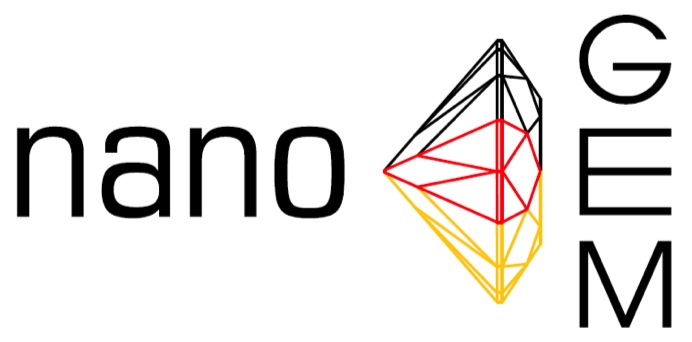
nanoGEM – Nanostructured Materials – health, exposure and material properties
The NanoGEM research project, funded by the BMBF and industry, was an integrative interdisciplinary project that carried out various research activities on nanosafety, exposure, risk, and toxicology in a combined effort of academia, authorities and industry. The results and findings obtained within NanoGEM were published in international journals (see NanoGEM publications) and included in the international harmonisation process and the public dialogue. In addition, practical safety proposals and standard operating procedures (SOP) were developed and published.
The specific research activities were divided into seven work packages. Knowledge of the basic properties of nanomaterials (NM) plays an essential role in the investigation and assessment of safety issues relevant to humans and the environment.
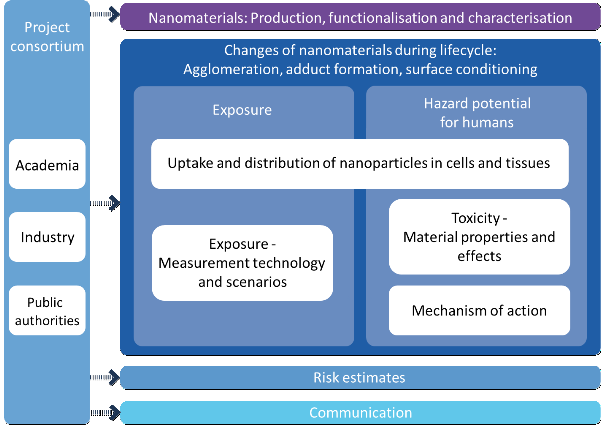
NanoGEM Project Description
The work packages “production, functionalisation and characterisation of nanomaterials” mainly dealt with the development and allocation of new materials with modified basic properties, and modified surfaces in particular. The surfaces of selected nanomaterials such as silver (Ag), silicon dioxide (SiO2), and zirconium dioxide (ZrO2) were specifically modified and thoroughly characterised in water and relevant biological media together with other reference and comparison materials. Labelling of silicon dioxide and titanium dioxide (TiO2) nanoparticles with the fluorescent marker FITC (fluoresceine isothiocyanate) allowed for identification, localisation and mobility tracking of these nanoparticles in different media.
Studies within the work package “exposure – measuring techniques and scenarios” investigated the basic principles required for exposure assessment, release mechanisms and measuring strategies. The results of the main questions like “Is it possible to reproduce and simulate certain release scenarios in the laboratory in a comparable way?” and “Which measuring techniques and strategies can be used for exposure studies?” were integrated into a testing strategy which meanwhile has been included in the OECD program of the Working Party of Manufactured Nanomaterials (WPMN).
In a special work package called “cross-cutting issues: nanomaterial modifications”, modifications of the properties of nanomaterials over the entire life cycles were analysed placing emphasis on the lungs as the most health-relevant routes of entry of nanomaterials into the body.
Surface functionalisation had an essential influence on the adsorption behaviour of the lung surfactant lipids’ towards the nanomaterials such that after attachment of the different components (lipids, proteins, organic compounds), there was no direct contact between the surface of the nanomaterials and the surrounding medium. In the alveoli or at the air-epithelium interface, the once stable suspensions of the respective nanoparticles (SiO2 FITC, adsorptively labelled ZrO2) agglomerated over the entire observation period (30 – 180 min) resulting from the interaction with the proteins of the lung alveoli.
Within the topic “nanoparticle toxicology: material properties and effects”, in vitro and in vivo analyses were carried out on sensitised mice, among others. Whereas, in both scenarios, the unmodified silicon dioxide nanomaterials were found to cause the strongest effects, no significant reactions were observed in the amino- and phosphate-functionalised SiO2 materials. The risk-related studies revealed that the risk potential of a substance can be changed through surface modification and that this may lead to a better matrix integration.
For risk assessment, various data on chemical safety, occupational health and safety, and consumer protection were compiled and evaluated. For the derivation of the risk assessment of nanomaterials within the context of chemical safety legislation specific data on the endpoints related to the three selected nanoscale materials silicon dioxide, silver, and zirconium dioxide were collected and analysed. The evaluation revealed that, in view of the fact that no solely nano-specific modes of action have been identified so far and that conventional risk assessment principles can also be applied to nanomaterials.
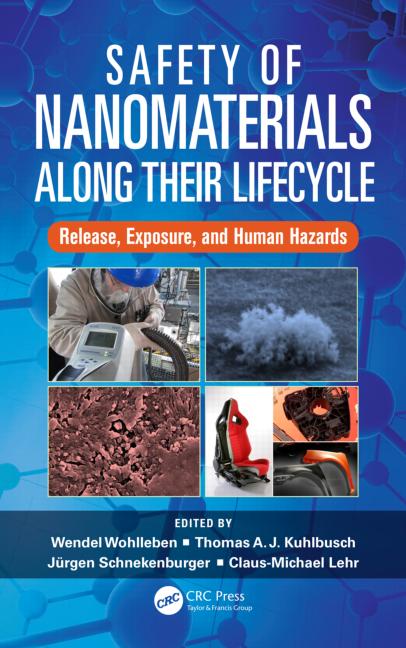
Wohlleben W., Kuhlbusch T.A.J., Schnekenburger J., Lehr C.M. (2015). Safety of Nanomaterials along Their Lifecycle: Release, Exposure, and Human Hazards. Taylor & Francis Inc, CRC Press, pp. 472. ISBN: 9781466567863.
Grant Number: BMBF - FKZ 03X0105
Duration: 01.08.2010 - 31.07.2013 (extended to 31.10.2013)
Project Lead
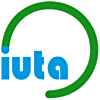
Project Partners






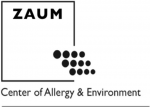



Associated Partners
Publications
2015
- Silge A., Brautigam K., Bocklitz T., Rosch P., Vennemann A., Schmitz I., Popp J., Wiemann M. (2015). ZrO nanoparticles labeled via a native protein corona: detection by fluorescence microscopy and Raman microspectroscopy in rat lungs. Analyst, DOI:10.1039/c5an00942a
2014
- Buesen R., Landsiedel R., Sauer U.G., Wohlleben W., Groeters S., Strauss V., Kamp H., Van Ravenzwaay B. (2014). Effects of SiO(2), ZrO(2), and BaSO(4) nanomaterials with or without surface functionalization upon 28-day oral exposure to rats. Arch Toxicol, 88(10): 1881-1906.
- Bräutigam K., Bocklitz T., Silge A., Dierker C., Ossig R., Schnekenburger J., Cialla D., Rösch P., Popp J. (2014). Comparative two- and three-dimensional analysis of nanoparticle localization in different cell types by Raman spectroscopic imaging. Journal of Molecular Structure, 1073(0): 44-50.
- Landsiedel R., Ma-Hock L., Hofmann T., Wiemann M., Strauss V., Treumann S., Wohlleben W., Groters S., Wiench K., Van Ravenzwaay B. (2014). Application of short-term inhalation studies to assess the inhalation toxicity of nanomaterials. Part Fibre Toxicol, 11(1): 16.
- Wagner, T., H.-G. Lipinski, M. Wiemann (2014). Dark field nanoparticle tracking analysis for size characterization of plasmonic and non-plasmonic particles. J Nanopart Res 16(5): 1-10.
- Wohlleben W., Vilar G., Fernandez-Rosas E., Gonzalez-Galvez D., Gabriel C., Hirth S., Frechen T., Stanley D., Gorham J., Sung L.P., Hsueh H.C., Chuang Y.F., Nguyen T., Vazquez-Campos S. (2014). A pilot interlaboratory comparison of protocols that simulate aging of nanocomposites and detect released fragments. Environ Chem, 11(4): 402-418.
2013
- Wagner T., M. Wiemann, I. Schmitz, H.-G. Lipinski (2013). A Cluster-Based Method for Improving Analysis of Polydisperse Particle Size Distributions Obtained by Nanoparticle Tracking. Journal of Nanoparticles (2013) 2013, 936150.
- Kaminski H., T.A.J. Kuhlbusch, S. Rath, U. Goetz, M. Sprenger, D. Wels, J. Polloczek, V. Bachmann, H.-J. Kiesling, A. Schwiegelshohn, N. Dziurowitz, C. Monz, D. Dahmann, C. Asbach (2013). Comparability of mobility particle sizers and diffusion chargers. Journal of Aerosol Science 57 (2013) 156–178.
- Plitzko S., N. Dziurowitz, C. Thim, Ch. Asbach, H. Kaminski, M. Voetz, U. Goetz, D. Dahmann (2013). Messung der inhalativen Exposition gegenueber Nanomaterialien - Moeglichkeiten und Grenzen. Gefahrstoffe - Reinhaltung der Luft" 73(2013) Nr. 7/8, S. 295-301.
2012
- Hellack B., T. Huelser, E. Izak, T. Kuhlbusch, F. Meyer, M. Spree, M. Voetz, H. Wiggers, W. Wohlleben (2012). Characterization report for all nanoGEM materials. Deliverable 1.2.1 (Sept. 2012). [Report ]
- Asbach C., H. Kaminski, D. Von Barany, T.A.J. Kuhlbusch, C.Monz, N. Dziurowitz, J. Pelzer, K. Berlin, S. Dietrich, U. Goetz, H.-J. Kiesling, R. Schierl, D. Dahmann (2012). Comparability of portable nanoparticle exposure monitors. Annals of Occupational Hygiene 56 (2012) 606.
- NanoGEM - Konsortium (26.06.2012). Tiered Approach for the assessment of exposure to airborne nanoobjects in work-places. (PDF, 700 KB)
- NanoGEM - Konsortium (28.09.2012). Short-Term Inhalation Study in Rats for Testing of Nanomaterials. (PDF, 400 KB)
- NanoGEM - Konsortium (16.03.2011). Preparing suspensions of nanomaterials in serum-containing medium. (PDF, 92 KB)
2013
- Wagner T. , M. Wiemann, I. Schmitz, H.-G. Lipinski (2013). Applications of a cluster-based method for analysis of polydisperse size distributions obtained by Single Particle Tracking of Nanoparticles. EuroNanoForum 2013, 18.-20.06.2013, Dublin, Irland. [Poster ]
- Asbach C. (2013). Exposition - Messtechnik und Szenarien. nanoGEM-Abschluss-konferenz, 12.-13.06.2013, Berlin. [Vortrag ]
- Cramer S., D. Wang, A.K. Sachan, H-J. Galla (2013). Adsorption of lipids on the surface of differently modified nanoparticles, nanoGEM-Abschlusskonferenz, 12. - 13.06.2013, Berlin. [Poster ]
- Haase A. , W. Wohlleben (2013). APQ: Veraenderung von Nanomaterialien-Agglomerationsgrad, Adduktbildung und Konditionierung. nanoGEM-Abschlusskonferenz, 12.-13.06.2013, Berlin. [Vortrag ]
- Kuhlbusch, T.A.J. (2013). nanoGEM Schlaglichter. nanoGEM-Abschlusskonferenz, 12.-13.06.2013, Berlin. [Vortrag ]
- Kuhlbusch, T.A.J. (2013). nanoGEM Highlights. nanoGEM-Abschlusskonferenz, 12.-13.06.2013, Berlin. [Vortrag ]
- Voetz M., W. Wohlleben (2013). Produktion und Charakterisierung der nanoGEM Materialien. nanoGEM-Abschlusskonferenz, 12.-13.06.2013, Berlin. [Vortrag ]
- Gebel T. (2013). Risikoabschaetzung von Nanomaterialien aus Sicht des Arbeits- und Verbraucherschutzes. nanoGEM-Abschlusskonferenz, 12.-13.06.2013, Berlin. [Vortrag ]
- Packroff R. (2013). Ressortforschung fuer sichere Nanotechnologien. nanoGEM-Abschlusskonferenz, 12.-13.06.2013, Berlin. [Vortrag ]
- Gebel T., M. Oeben-Negele, D. Geiger, E. Dopp (2013). Hazard assessment of selected nanomaterials and approaches for risk assessment at the workplace. nanoGEM-Abschlusskonferenz, 12.-13.06.2013, Berlin. [Poster ]
- Wohlleben W., S. Hirth, B. von Vacano, T. Nguyen, S. Vasquez (2013). Lifecycle of nanoGEM materials: weathering-induced release and lipid vesicle interactions. nanoGEM-Abschlusskonferenz, 12.-13.06.2013, Berlin. [Poster ]
- Wagner T., D. Schipprit, M. Wiemann, H.-G. Lipinsk (2013). Light microscopy and computer-based methods to analyse primary and agglomerated nanoparticles in liquids. nanoGEM-Abschlusskonferenz, 12.-13.06.2013, Berlin. [Poster ]
- Hittinger M., S. Raesch, C. Ruge, C. Schulze, H. Huwer, N. Daum, U. Schaefer, C.-M. Lehr (2013). Interaction of nanosized SiO2-FITC-labelled particles with the barriers of the deep lung. nanoGEM-Abschlusskonferenz, 12.-13.06.2013, Berlin. [Poster ]
- Asbach C., D. Dahmann, M. Voetz, B. Stahlmecke, H. Kaminski, T. Kuhlbusch, U. Goetz, S. Engel, S. Plitzko (2013). Assessment of exposure to airbone nanomaterials using a pragmatic, tiered approach. nanoGEM-Abschlusskonferenz, 12.-13.06.2013, Berlin. [Poster ]
- Riebling C., A. Koeth, H. Kaminski, T. Kuhlbusch, A. Luch, M. Goetz (2013). Assessment of exposure to nanomaterials through consumer products. nanoGEM-Abschlusskonferenz, 12.-13.06.2013, Berlin. [Poster ]
- Kuhlbusch T.A.J., C. Asbach, W. Wohlleben, R. Landsiedel, M. Voetz, E. Dopp, S. Plitzko, A. Luch, M. Goetz, A. Haase, H-G. Lipinski, M. Wiemann, D. Dahmann, F. Meyer, J. Schnekenburger, C-H. Lehr, R. Braeunig, F. Alessandrini, T. Teckentrup, J. Popp, D. Breitenstein, P. Nollau und das nanoGEM-Konsortium (2013). Nanostrukturierte Materialien Gesundheit, Exposition und Materialeigenschaften. nanoGEM-Abschlusskonferenz, 12.-13.06.2013, Berlin. [Poster ]
- Kuhlbusch T.A.J., C. Asbach, W. Wohlleben, R. Landsiedel, M. Voetz, E. Dopp, S. Plitzko, A. Luch, M. Goetz, A. Haase, H-G. Lipinski, M. Wiemann, D. Dahmann, F. Meyer, J. Schnekenburger, C-H. Lehr, R. Braeunig, F. Alessandrini, T. Teckentrup, J. Popp, D. Breitenstein, P. Nollau und das nanoGEM-Konsortium (2013). nanoGEM - Nanostrukturierte Materialien Gesundheit, Exposition und Materialeigenschaften. 3. Clustertreffen der BMBF-Foerdermaßnahmen NanoCare und NanoNature, Frankfurt am Main, 14.-15. Januar 2013. [Poster ]
- Kuhlbusch T.A.J. (2013). nanoGEM Nanomaterialien - Gesundheit, Exposition und Materialeigenschaften. 3. Clustertreffen der BMBF-Foerdermaßnahmen NanoCare und NanoNature, Frankfurt am Main, 14.-15. Januar 2013. [Vortrag ]
- Wagner T. (2013). Nanoparticle Tracking: Improving Analysis for Size Distributions of Polydisperse Particle Suspensions. 3. Clustertreffen der BMBF-Foerdermaßnahmen NanoCare und NanoNature, Frankfurt am Main, 14.-15. Januar 2013. [Poster ]
- Koeth A., H. Kaminski, T. Kuhlbusch, A. Luch, M. Goetz (2013). Expositionsabschaetzung von Nanomaterialien aus verbrauchernahen Produkten. 3. Clustertreffen der BMBF-Foerdermaßnahmen NanoCare und NanoNature, Frankfurt am Main, 14.-15. Januar 2013. [Poster ]
- Gebel T., M. Oeben-Negele, D. Geiger, E. Dopp (2013). Risikoabschaetzung von ausgewaehlten Nanomaterialien und Ansaetze zur Gefaehrdungsabschaetzung am Arbeitsplatz., 3. Clustertreffen der BMBF-Foerdermaßnahmen NanoCare und NanoNature, Frankfurt am Main, 14.-15. Januar 2013. [Poster ]
- Ossig R., M. Wiemann, M. Nern, E. Dopp, M. Driessen, A. Luch, A. Haase, P. Nollau, D. Hahn, J. Schneckenburger (2013). Wirkmechanismen der Toxizitaet von Nanomaterialien. 3. Clustertreffen der BMBF-Foerdermaßnahmen NanoCare und NanoNature, Frankfurt am Main, 14.-15. Januar 2013. [Poster ]
- Marzaoioli V., C.J. Thomas, M. Wiemann, R. Landsiedel, W. Wohlleben, I. Wichenmeier, H. Behrendt, C. Schmidt-Weber, O. Groß, J. Gutermuth, F. Alessandrini (2013). Oberflaechenmodifikationen von Silika Nanopartikeln fuehren zu einer verringerten Inflammasomaktivierung und verringerter Expression ausgewaehlter inflammatorischer Gene. 3. Clustertreffen der BMBF-Foerdermaßnahmen NanoCare und NanoNature, Frankfurt am Main, 14.-15. Januar 2013. [Poster ]
- Vennemann A., B. Breitenstein, P. Roesch, A. Silge, J. Popp, M. Wiemann (2013). Detection of SiO2 and Ag Nanoparticles in the Lung. 3. Clustertreffen der BMBF-Foerdermaßnahmen NanoCare und NanoNature, Frankfurt am Main, 14.-15. Januar 2013. [Poster ]
- Asbach C., D. Dahmann, M. Voetz, B. Stahlmecke, H. Kaminski, T. Kuhlbusch, U. Goetz, S. Engel, S. Plitzko (2013). Tiered Approach zur Erfassung der Arbeitsplatzexposition gegenueber luftgetragenen Nanopartikeln. 3. Clustertreffen der BMBF-Foerdermaßnahmen NanoCare und NanoNature, Frankfurt am Main, 14.-15. Januar 2013. [Poster ]
- Asbach C., B. Stahlmecke, H. Kaminski, S. Kreckel, M. Voetz, S. Plitzko, M. Meier, W. Wohlleben (2013). Untersuchungen zur Freisetzung von Nanomaterialien aus Kompositen und Pulvern. 3. Clustertreffen der BMBF-Foerdermaßnahmen NanoCare und NanoNature, Frankfurt am Main, 14.-15. Januar 2013. [Poster ]
2012
- Wagner T., S.O. Luettmann, D. Swarat, M. Wiemann, H.-G. Lipinski (2012). Pfadbasierte Identifikation von Nanopartikel-Agglomerationen in vitro. in T. Tolxdorff et al. (Hrsg.) Bildverarbeitung fuer die Medizin 2012. Reihe Informatik aktuell. Springer Berlin, Heidelberg, New York, 2012‚ pp. 242-248. [Poster]
- Dahmann D. (2012). Messstrategien fuer Nanopartikel (unter besonderer Beruecksichtigung der CNT). SiGe-Fachveranstaltung: Umgang mit Nanomaterialien - Bestandsaufnahme CNT, 04.-05.10.2012, Bonn. [Vortrag ]
2011
- Wagner T., D. Swarat, M. Wiemann, H.-G. Lipinski (2011). Bildanalyse frei diffundierender Nanopartikel in vitro. H. Handels et al. (Hrsg.), Bildverarbeitung fuer die Medizin 2011. Reihe Informatik aktuell. Springer Verlag, Berlin, Heidelberg, 2011, pp. 349-353. [Poster]
- Wagner T., S. O. Luettmann, D. Swarat, M. Wiemann, H.-G. Lipinski (2011). Image analysis of free-diffusing nanoparticles in vitro. Proc. SPIE Biophotonics Vol. 7922 No. 79223B, 2011. [Poster]
- Hebert H., D. Breitenstein, M. Fartmann, R. ter Veen, B. Hagenhoff, R. Kersting, T.Grehl, P. Bruener, E. Niehuis (2011). Surface Characterisation of Nanoparticles: Different Surface Analytical Techniques Compared. 14th European Conference on Applications of Surface and Interface Analysis (ECASIA), 04.-09.9.2011, Cardiff, Wales, UK. [Vortrag ]
- Breitenstein D., R. Kersting, B. Hagenhoff, R. Moellers, E. Niehuis, M. Sperber, B. Goricnik, J. Wegener (2011). Detection of Micro- and Nanoparticles in Animal Cells by TOF-SIMS 3D Analysis. 14th European Conference on Applications of Surface and Interface Analysis (ECASIA), 04.-09.09.2011, Cardiff, Wales, UK. [Vortrag ]
- Auf die Oberfläche kommt es an: die Wirkung von Nanomaterialien. Pressemeldung der Universität Duisburg-Essen zur NanoGEM Abschlusskonferenz, 12.06.2013 (idw.de, 2013)
- Verträglichkeit - Nano bedeutet nicht gleich giftig. Beitrag zur Abschlusskonferenz NanoGEM 12./13. Juni 2013 in Berlin. Zeit-Online, 13.06.2013. (zeit.de, 2013)
- NanoGEM erfolgreich gestartet - Bergen Nanomaterialien gesundheitsrelevante Risiken? wenn ja, wie sind sie vermeidbar? Pressemitteilung Institut für Energie- und Umwelttechnik (IUTA) e.V., 2010
 >
>